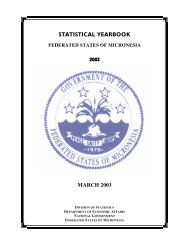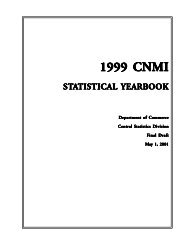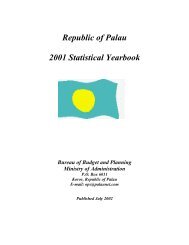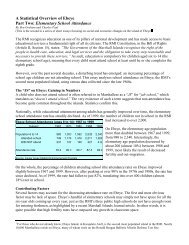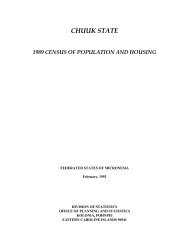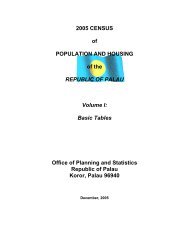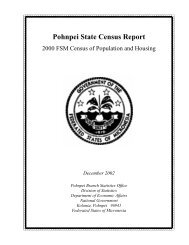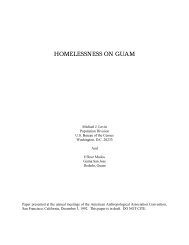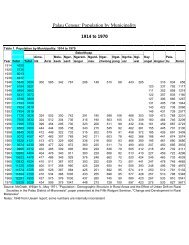Chuuk State Census Report - pacificweb.org
Chuuk State Census Report - pacificweb.org
Chuuk State Census Report - pacificweb.org
Create successful ePaper yourself
Turn your PDF publications into a flip-book with our unique Google optimized e-Paper software.
CHAPTER 4FERTILITYIntroductionBefore large-scale international migration became common, population growth was determined mostly by thedifference between the number of people being born and the number of people dying. At present, births are not the onlycontributing factor to population growth, but they make up a significant portion, especially in the Pacific region wheremost families are characterized by a high level of fertility.Birth or fertility rates measure the impact that births have on population structure and growth. As a rule, censuses doquite well in estimating fertility as questions and techniques have been refined over the years. There are two approachesfor measuring fertility, direct measures and indirect measures, both of which can be applied to the 1994 and of 2000FSM <strong>Census</strong>es of <strong>Chuuk</strong>. Since either method can be used, a useful starting point is to compare the results obtainedfrom each. If the results differ widely, it suggests that the data used in one or both methods are incorrect, or one methoddoes not apply.Changes in fertility patterns and levels are often due to family planning. <strong>Census</strong> data on fertility provide benchmarkinformation on fertility to look for changes in patterns and levels. In many countries, the introduction of familyplanning methods, such as contraceptives, usually lowers fertility levels of older women first. In a nation where familyplanning is prevalent, we expect to see lower fertility levels for the older women.Data DescriptionVital registration in <strong>Chuuk</strong> is not complete, so estimates must be derived from a census or survey. The 2000 FSM<strong>Census</strong> of <strong>Chuuk</strong> asked four questions on fertility in order to get information on recent births, previous births, and childmortality. Fertility questions were asked to all females born before April 1, 1987 (all women aged 13 and over) butwere tabulated for women aged 15 and over. Question 17a asked how many children born to each woman and wereliving at home, living elsewhere, or dead and categorized by sex. Questions 17b to 17d asked the date and sex of thelast child born alive and whether that child was still alive.Limitations and comparability. Accurate fertility data are often difficult to capture because of poor recollection bymothers on number of births or dates of births of their children. Indirect methods of measuring fertility help tocompensate for these weaknesses in the data. The 1973 TTPI <strong>Census</strong> asked questions on children ever born, childrenstill alive and date of the last child born, by sex, to women aged 14 years and over. The 1980 <strong>Census</strong> asked women 15and over for number of children ever born and surviving and babies born in the 12 months before the census. The 1980collection technique would have caught women who had multiple births in the year, while the 1973, 1994 and 2000only considered most recent births, missing those women who had multiple births in the year before the census. Theediting techniques on fertility data for the earlier censuses were slightly different from the 1994 and 2000 FSM<strong>Census</strong>es of <strong>Chuuk</strong>.Analysis of Fertility DataCrude Birth RateA crude birth rate (CBR) is the number of births in a year divided by the mid-period population. Note that the midperiodpopulation is not the census population, that is, the reported births refer to the last 12 months, while thepopulation refers to the date of enumeration. The CBR is a crude rate because the base of the calculation is the wholepopulation, resulting in the rate being affected by the age and sex structure.Two measures of how many births occurred in the 12 months prior to the census can be derived from census data. Thefirst is the number of births reported by women in the census; the second is the population under 1 year plus theestimated number of infant deaths (deaths during the year to persons under 1 year). These two figures were not equalfor the period April 2, 1999 through April 1, 2000.<strong>Chuuk</strong> Branch Statistics Office, Division of Statistics, FSM Department of Economic Affairs 35



